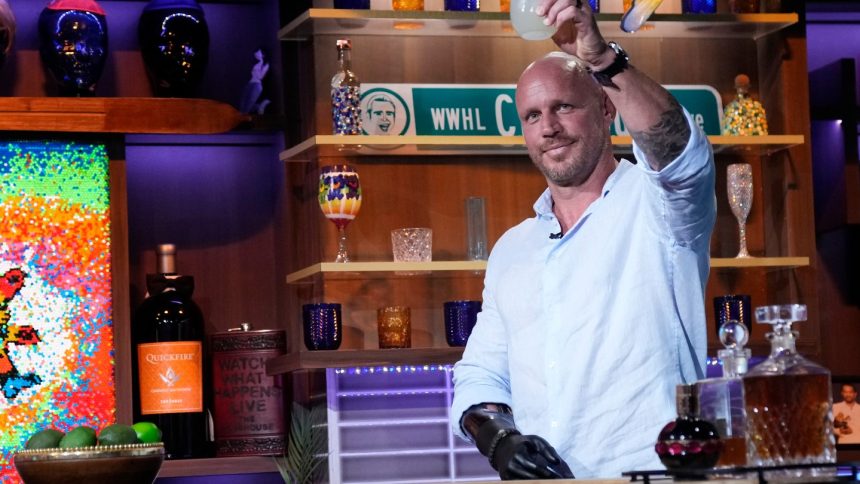Paul de Gelder’s Unlikely Path From a Near-Fatal Attack to ‘Shark Week’ Stardom
Paul de Gelder had given up on his life in the delirious moment 16 years ago when he found himself in Sydney Harbor swimming through a pool of his own blood. An Australian Navy clearance diver at the time, he was rapidly losing blood after an encounter with a bullhead shark in a body of water known for spectacular views of the global capital’s landmarks — not known for sharks, and certainly not shark attacks. Luckily, De Gelder, maimed and bleeding out, managed to get it together enough to swim back to his team who, on that February morning, rapidly shifted from their planned routine counterterrorism drill to a medical triage, desperate to save their teammate’s life.
”I’m not going to lie. I thought I was going to die,” De Geder tells The Hollywood Reporter in an interview ahead for this year’s Shark Week, where he stars in four new shows for the annual Discovery event, that kicked off July 20, including a star turn in How to Survive a Shark Attack. “I just turned up to work one day for this very easy counterterrorism exercise right in the heart of Sydney Harbor, where there hasn’t been a shark attack in 50 years. And all of a sudden, a bull shark eats me for breakfast.”
As his colleagues quickly came to his aid, a teammate had to stick his hand inside De Gelder’s leg to pinch an artery closed. Later, a surgeon told him, “If he hadn’t done that, [De Gelder] would have bled out within 30 seconds.”
Then a career Australian Defense Forces officer, De Gelder says he felt the predator’s initial chomp, then turned to find himself face-to-face with the hungry bullhead; soon he was being thrashed around the water. The predator took a bite out of two of his limbs before De Gelder said he just decided to give up and wait for death. It was all over. This, he said, allowed the shark to rip off his hamstring and eat his right hand. This entire encounter lasted about eight seconds, but in the coming years, it changed De Gelder forever — not only physically, but the horrific moment in the water led him to redefine his entire life and career.
You Might Also Like
Many elements came into play that day to keep him alive, and his eternal gratitude is expressed for what people did in those moments after his living nightmare. This is why it is surprising to learn that for his spotlight hour of the 20 new shows being presented during this year’s Shark Week, De Geder decided to relive the attack, three times over, to show viewers just what to do if a shark ever tries to take a bite out of them.
How to Survive a Shark Attack may be the ideal vehicle for De Gelder, a familiar face from Discovery’s Shark Week; he’s appeared on shows during the popular TV event for a decade now. The new hour-long episode showcases his affable screen persona, sly humor and action-star charm as he challenges himself to go back to a moment nearly identical to the one in 2009 and taunt and provoke sharks, in the very place where his limbs were ripped to shreds. In fact, the man wears realistic prosthetics during the stunts to give viewers the full effect; red fake blood spills into the brilliant blue of the underwater ocean scenes, overtaking our screens as the 47-year-old goes over key survival skills, and as some taunted and upset sharks go hungry.
De Gelder’s decision to create a show recreating his maiming and near-death experience starts to feel less strange with a bit of knowledge on how he’s spent the past 16 years. While he’s yet to take extreme shark encounters as far as he does this year, over his decade working on Shark Week programming, he’s had several close shark encounters in the deep blue sea. Like the time he was free diving on an active underwater volcano while it was erupting and found himself confronted with a line of silky sharks, which “looked like they were lined up waiting to eat me for lunch,” he recalls. Or when, for a show called Sharkwrecked, he and a British Special Forces soldier drifted through the Atlantic Ocean for two days and nights with no food or water; they were surrounded on that journey by the same species of shark that were responsible for the attacks on the sinking of the U.S.S. Indianapolis. For De Gelder, fear is nothing if you remember to remain calm.
“If you start to panic, you lose your focus, you can’t think straight. You just have to remain calm and think through the situation and the scenario,” he told THR. “I always get a bit of nervous excitement right before I’m about to jump in the water. And I think that is fear, but I’ve learned over the years to switch it into a nervous excitement. It’s less like, ‘Oh my God, I don’t know what’s gonna happen.’ More like, ‘Oh my God! I don’t know what’s gonna happen!’ It’s so fun.”
He now enjoys a globe-trotting life, just this past year jetting to California for the show Black Mako of the Abyss and New Zealand for Air Jaws: The Hunt for Colossus, among other far-off aquatic locales. His life now is a far cry from the troubled Australian teen he was 30 years ago and of the many lives he’s lived since (“you get a little bit older, you turn to cigarettes and alcohol and fighting and stealing and all these bad things”). Gelder found himself adrift as a young man and, enjoying rhyming and perhaps destined for fame in some form, he became a minor rap star down under; he once opened a gig for Snoop Dogg. But as he entered his mid-20s, he chucked that out the window and joined the armed forces, answering the calls of adulthood first as a paratrooper and later in a select group of Navy clearance divers.
“I was like, ‘screw it,’” he said. “I’m 23 years old. I’m not going to be a bartender for the rest of my life. I need to do something. And so I ended up joining the army, and that was so healthy for me. I’ll always be grateful to the military for teaching me how to be a real man, a valuable member of society and allowing me to wear the maroon beret and the uniform of my country.”
In 2012, three years after his bloody encounter in Sydney Harbor, De Gelder faced his second biggest fear, after being ripped up by an underwater predator: public speaking.
“I started small and started getting bigger,” he recalled. “I got comfortable in front of people, in front of cameras, and then along comes Shark Week and asks me to interview for a show called I Survived Jaws.”
A stroke of luck put him in front of the camera when a stunt performer was a no-show, and performed the re-enactment himself. This led to another opportunity the following year, as a co-host on a show on great white sharks. The rest, for the man who became one of Shark Week’s biggest and most unlikely stars, is now history.
“Then it just got bigger and bigger and bigger,” De Gelder recalled. “This year I’ve got four new shows. I’m a small-town Australian kid. I grew up watching documentaries just like these, and my heroes were on TV having adventures. And now I get to walk in their footsteps. Incredible. What more could you ask for?”







